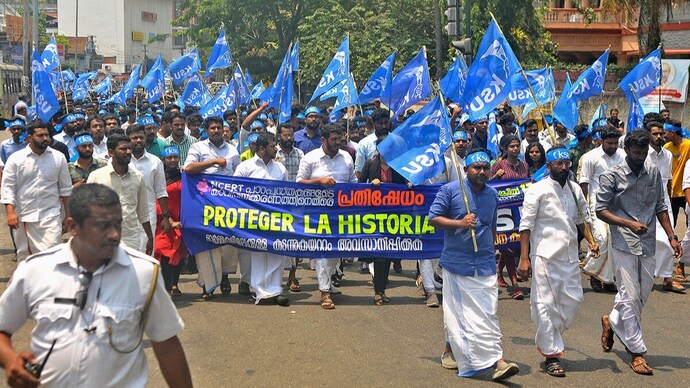– Abdul Bari Masoud
The history of a nation constitutes its soul. Tampering with that history is tantamount to tampering with the foundational ideals and values of India.”
That’s how K. M. Jawahirullah, a Tamil Nadu legislator and education activist, describes what is unfolding in India’s classrooms today. His statement captures the crux of a controversy that has been simmering for years but has now reached a boiling point: the rewriting of school textbooks by NCERT allegedly under the pressure of RSS.
When the new academic session began this April, history teachers across India opened the latest editions of NCERT textbooks with a mix of curiosity and unease. Pages that once carried detailed accounts of Mughal emperors, Delhi Sultanate rulers, and the cultural contributions of India’s Muslim past now read very differently.
“We were stunned,” said a history teacher at a government school in Lucknow, requesting anonymity. “Entire chapters on the Mughal Empire are either cut down or completely erased. Students asked, ‘Where did Aurangzeb go?’ How do I answer that?”
The 2024 revisions in NCERT textbooks, following the “curriculum rationalisation” exercise, have sparked a national debate. Critics allege a deliberate rewriting of history to sideline Muslim contributions, while officials argue it’s an attempt to “decolonise” and “streamline” content for better learning outcomes.
The Vanishing of Mughals
One of the most striking changes is the treatment of the Mughal Empire, a dynasty that ruled India for over 300 years. Earlier editions of the Class 7 history book Our Past–II had an entire chapter titled “The Mughal Empire” with sections on Akbar’s policies of Sulh-i-Kul (universal peace), his inclusive governance, and the cultural syncretism that flourished under Mughal patronage.
The new version compresses this to a few paragraphs, removing references to Akbar’s dialogues with religious leaders in the Ibadat Khana, his abolition of jizya on non-Muslims, the role of Mughal emperors in building a composite culture.
In the 2022 edition, a passage read that “Akbar’s policy of Sulh-i-Kul aimed at universal peace. He believed in tolerance of all religions and abolished discriminatory taxes, earning respect from both Hindus and Muslims.”
The 2024 edition replaces this with a curt sentence that “Mughal rulers adopted various administrative measures during their reign.”
The nuance, say historians, is gone.
“Reducing three centuries of complex history into a bland line is not simplification; it’s erasure,” argues Prof. Irfan Habib, noted historian and former chairman of the Indian Council of Historical Research. “The Mughals shaped India’s architecture, art, and politics. Students deserve to know that.”
From Delhi Sultanate to ‘Invasions’
The Delhi Sultanate, too, has been reframed. Earlier textbooks discussed the establishment of the Sultanate as a political development influenced by multiple factors. The new texts emphasise “invasions” rather than state-building.
In the previous edition of Themes in Indian History (Class 12), students read that “The Delhi Sultanate laid the foundations of a centralised state. It introduced reforms in administration, land revenue, and military organisation, influencing future governance in India.”
The revised edition states that “The period saw repeated invasions that led to political instability and hardship for the local population.”
The emphasis has shifted from governance and cultural synthesis to a narrative of aggression and disruption.
A Shrinking Space for Cultural Contributions
Sections on Urdu literature, the rise of Sufism, and the syncretic Bhakti movement are trimmed. The chapter on the Sufi-Bhakti tradition, once rich with verses from Kabir and Bulleh Shah, now omits most references to the Muslim poets.
Similarly, Mughal art and architecture, which included masterpieces like the Taj Mahal, Red Fort, and Fatehpur Sikri, now appears only in fleeting mentions. Even the iconic sentence — ”The Taj Mahal is one of the seven wonders of the world” — has disappeared from some state textbooks.
“These omissions are not neutral edits; they reshape what young minds perceive as ‘Indian culture,’” notes Prof. Farhat Hasan, historian at Delhi University. “If you remove the Muslim imprint, you create an India imagined without its actual diversity.”
Also gone are Tipu Sultan and Haider Ali, iconic Mysore rulers who fought the British fiercely. “Deleting Mughal history also means deleting Sikh history,” warns Sikh activist Sardar Daya Singh, noting that the Mughal period was crucial to Sikh identity and resistance movements.
Jawahirullah calls these omissions “not an academic correction, but a political propaganda tool.” He alleges that the new Social Science textbook “vilifies Muslim rulers as unethical invaders and erases their contributions to India’s composite culture.”
‘De-burdening’ or De-Othering?
NCERT officials insist these changes aim to reduce content load for students and make textbooks more “India-centric.”
But the deletions coincide with ideological positions advanced by the ruling dispensation. The push to foreground “ancient Indian knowledge systems” often comes with a parallel dilution of Islamic and Mughal legacies.
In the new Class 6 social science book, an entire chapter is devoted to the glories of Vedic civilisation, including details on Ayurveda, Sanskrit literature, and mathematics. This in itself is contentious because the absence of balance troubles scholars.
“When you expand one segment and erase another, it is not rationalisation — it’s re-imagination,” says historian Romila Thapar. “Education is not about feeding pride alone; it is about confronting complexity.”
For many, the deletions risk creating historical amnesia and worse, a skewed sense of identity.
Politics in the Margins
The rewriting of history is not new. Every regime tweaks schoolbooks. But what stands out now is the scale and ideological thrust. In Parliament, Opposition leaders accused the government of “whitewashing” history. Congress MP Jairam Ramesh said: “This is not rationalisation. This is communalisation of education.”
The BJP-led government made a bizarre argument that it was correcting “distortions” introduced by “colonial and leftist historians.”
The ideological battlefield now runs through the pages of Class 6–12 textbooks, where the young are the silent audience.
A Glimpse into the New Narrative
The new textbooks project an India rooted in antiquity, defined by Vedic “wisdom”, and occasionally punctuated by colonial encounters. The medieval, especially the Muslim medieval, shrinks into an interlude of invasions and turmoil—hardly the bridge it once was.
A Class 8 student in Delhi summed it up after flipping through his fresh copy: “It’s like history jumped from Ashoka to the British.”
The NCERT says further revisions will align all subjects with the upcoming National Curriculum Framework. If current trends hold, the emphasis on “Bharatiya knowledge” will deepen, while contested pasts may fade further.
NCERT textbooks shape the worldview of millions of students across 24,000 CBSE-affiliated schools. What children read at 12 or 17 becomes their historical truth. By selectively removing chapters on secularism, caste discrimination, and popular movements, and by glorifying certain regimes while demonising others, critics argue the government is engineering a majoritarian imagination of the nation.
Today, as classrooms are scrubbed clean of inconvenient truths and re-scripted to echo a single narrative, the question is stark: What kind of republic will the next generation inherit?




